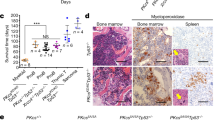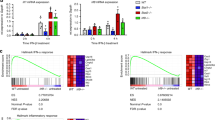Abstract
nfkb2 encodes two members of the NF-κB/Rel family of proteins: p52 and p100. The p100 polypeptide has been proposed to serve as a precursor of p52, which corresponds to the N-terminal half of p100. While p52 functions as a Rel transcription factor, the larger p100 protein acts as a cytoplasmic inhibitor of select NF-κB/Rel transcription factor complexes. Because of their distinct functions, we have studied the biochemical basis for the production of these two nfkb2-derived gene products. Like the p50 product of the nfkb1 gene, p52 is principally generated in a cotranslational manner involving proteolytic processing by the proteasome. The generation of p52 is dependent on a glycine-rich region (GRR) located upstream of the p52 C-terminus, and repositioning of this GRR alters the location of proteasome processing. In most cells, small amounts of p52 are produced relative to the levels of p100, unlike the usually balanced production of nfkb1-derived p50 and p105. Using p100/p105 chimeras containing different segments of the nfkb1 and nfkb2 genes, we have found that diminished p52 processing is a property conferred by peptide sequences located downstream of the GRR, flanking the site of p52 processing.
This is a preview of subscription content, access via your institution
Access options
Subscribe to this journal
Receive 50 print issues and online access
$259.00 per year
only $5.18 per issue
Buy this article
- Purchase on Springer Link
- Instant access to full article PDF
Prices may be subject to local taxes which are calculated during checkout






Similar content being viewed by others
Abbreviations
- RHD:
-
Rel homology domain
- GRR:
-
glycine-rich region
- NLS:
-
nuclear localization sequence
References
Baeuerle PA and Baltimore D. . 1996 Cell 87: 13–20.
Baeuerle PA and Henkel T. . 1994 Annu. Rev. Immunol. 12: 141–179.
Baumeister W, Walz J, Zuehl F and Seemueller E. . 1998 Cell 92: 367–380.
Baldwin AJ. . 1996 Annu. Rev. Immunol. 14: 649–683.
Barnes PJ and Karin M. . 1997 N. Engl. J. Med. 336: 1066–1071.
Beraud C, Sun SC, Ganchi P, Ballard DW and Greene WC. . 1994 Mol. Cell. Biol. 14: 1374–1382.
Betts JC and Nabel GJ. . 1996 Mol. Cell. Biol. 16: 6363–6371.
Bours V, Burd PR, Brown K, Villalobos J, Park S, Ryseck RP, Bravo R, Kelly K and Siebenlist U. . 1992 Mol. Cell. Biol. 12: 685–695.
Bours V, Franzoso G, Azarenko V, Park S, Kanno T, Brown K and Siebenlist U. . 1993 Cell 72: 729–739.
Brown K, Gerstberger S, Carlson L, Franzoso G and Siebenlist U. . 1995 Science 267: 1485–1488.
Caamano JH, Rizzo CA, Durham SK, Barton DS, Raventos SC, Snapper CM and Bravo R. . 1998 J. Exp. Med. 187: 185–196.
Crowley KS, Reinhart GD and Johnson AE. . 1993 Cell 73: 1101–1115.
Duckett CS, Perkins ND, Kowalik TF, Schmid RM, Huang ES, Baldwin AJ and Nabel GJ. . 1993 Mol. Cell. Biol. 13: 1315–1322.
Feuillard J, Korner M, Israel A, Vassy J and Raphael M. . 1996 Eur. J. Immunol. 26: 2547–2551.
Franzoso G, Carlson L, Poljak L, Shores EW, Epstein S, Leonardi A, Grinberg A, Tran T, Scharton KT, Anver M, Love P, Brown K and Siebenlist U. . 1998 J. Exp. Med. 187: 147–159.
Frydman J, Nimmesgern E, Ohtsuka K and Hartl FU. . 1994 Nature 370: 111–117.
Ghosh S, Gifford AM, Riviere LR, Tempst P, Nolan GP and Baltimore D. . 1990 Cell 62: 1019–1029.
Gilmore TD, Koedood M, Piffat KA and White DW. . 1996 Oncogene 13: 1367–1378.
Grumont RJ and Gerondakis S. . 1994 Cell 5: 1321–1331.
Ishikawa H, Carrasco D, Claudio E, Ryseck RP and Bravo R. . 1997 J. Exp. Med. 7: 999–1014.
Kieran M, Blank V, Logeat F, Vandekerckhove J, Lottspeich F, Le BO, Urban MB, Kourilsky P, Baeuerle PA and Israel A. . 1990 Cell 62: 1007–1018.
Lin L and Ghosh S. . 1996 Mol. Cell. Biol. 16: 2248–2254.
Lin L, DeMartino GN, Greene WC. . 1998 Cell 92: 819–828.
Liou HC, Sha WC, Scott ML and Baltimore D. . 1994 Mol. Cell. Biol. 14: 5349–5359.
Mercurio F, DiDonato JA, Rosette C and Karin M. . 1993 Genes Dev. 7: 705–718.
Neri A, Chang CC, Lombardi L, Salina M, Corradini P, Maiolo AT, Chaganti RS and Dalla FR. . 1991 Cell 67: 1075–1087.
Neri A, Fracchiolla NS, Migliazza A, Trecca D and Lombardi L. . 1996 Leuk. Lymphoma 23: 43–48.
Rice NR, MacKichan ML and Israel A. . 1992 Cell 71: 243–253.
Schmid RM, Perkins ND, Duckett CS, Andrews PC and Nabel GJ. . 1991 Nature 352: 733–736.
Siebenlist U, Franzoso G and Brown K. . 1994 Annu. Rev. Cell. Biol. 10: 405–455.
Zhang Q, Didonato JA, Karin M and McKeithan TW. . 1994 Mol. Cell. Biol. 14: 3915–3926.
Acknowledgements
We thank R Benitez for assistance in reagent preparation; C de Noronha and S Ferrell for helpful discussions; J Carroll, N Shea, S Gonzales, and C Goodfellow for assistance in the preparation of the figures; S Ordway and G Howard for editorial assistance; and R Givens for preparation of the manuscript. This work was supported in part by a grant from the UCSF-GIVI Center for AIDS Research (P30A127763). R Geleziunas is supported by a Centennial Fellowship from the Medical Research Council of Canada.
Author information
Authors and Affiliations
Rights and permissions
About this article
Cite this article
Heusch, M., Lin, L., Geleziunas, R. et al. The generation of nfkb2 p52: mechanism and efficiency. Oncogene 18, 6201–6208 (1999). https://doi.org/10.1038/sj.onc.1203022
Received:
Revised:
Accepted:
Published:
Issue Date:
DOI: https://doi.org/10.1038/sj.onc.1203022
Keywords
This article is cited by
-
Role of Transcription Factors in the Management of Preterm Birth: Impact on Future Treatment Strategies
Reproductive Sciences (2023)
-
p52 signaling promotes cellular senescence
Cell & Bioscience (2022)
-
Proteasome-dependent truncation of the negative heterochromatin regulator Epe1 mediates antifungal resistance
Nature Structural & Molecular Biology (2022)
-
Non-canonical NF-κB signaling pathway
Cell Research (2011)
-
Bortezomib decreases Rb phosphorylation and induces caspase-dependent apoptosis in Imatinib-sensitive and -resistant Bcr-Abl1-expressing cells
Oncogene (2010)



